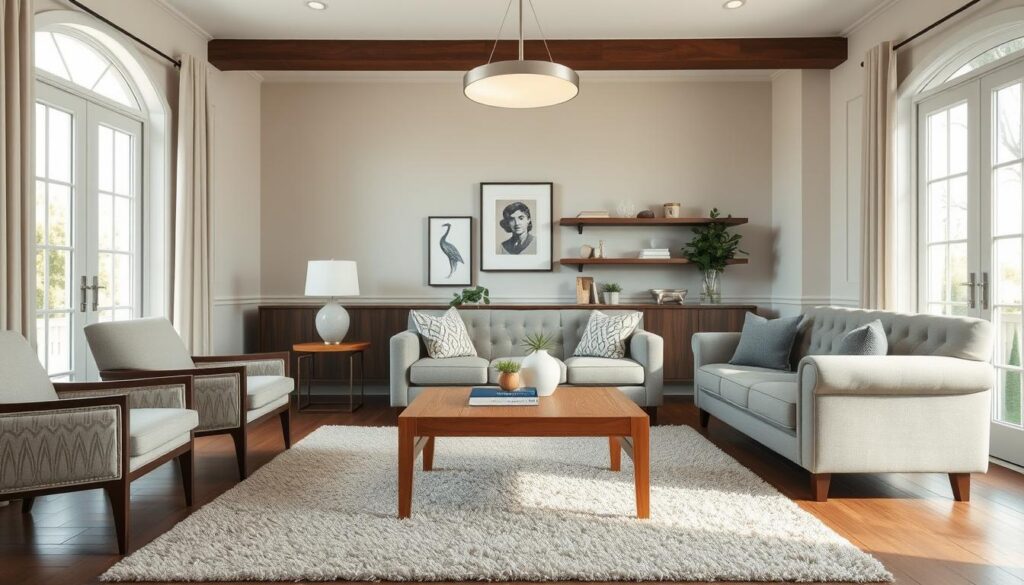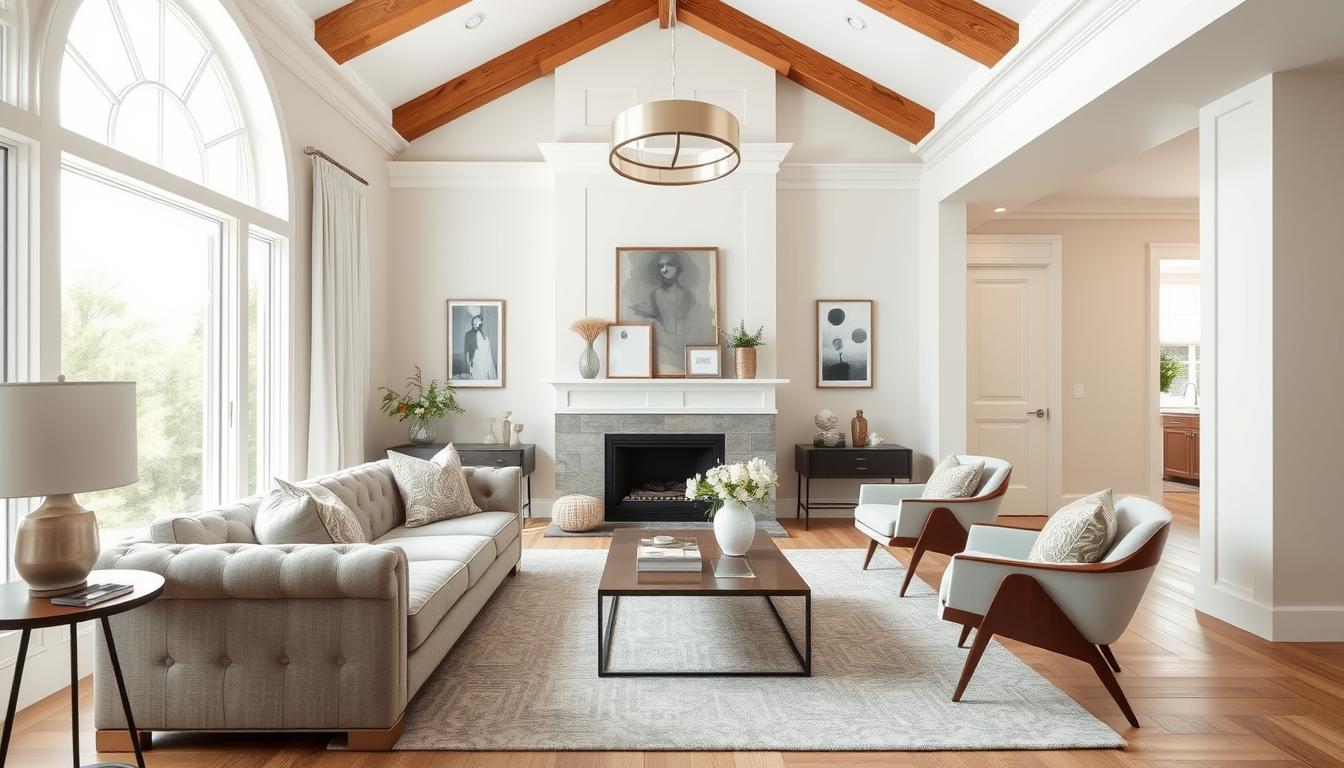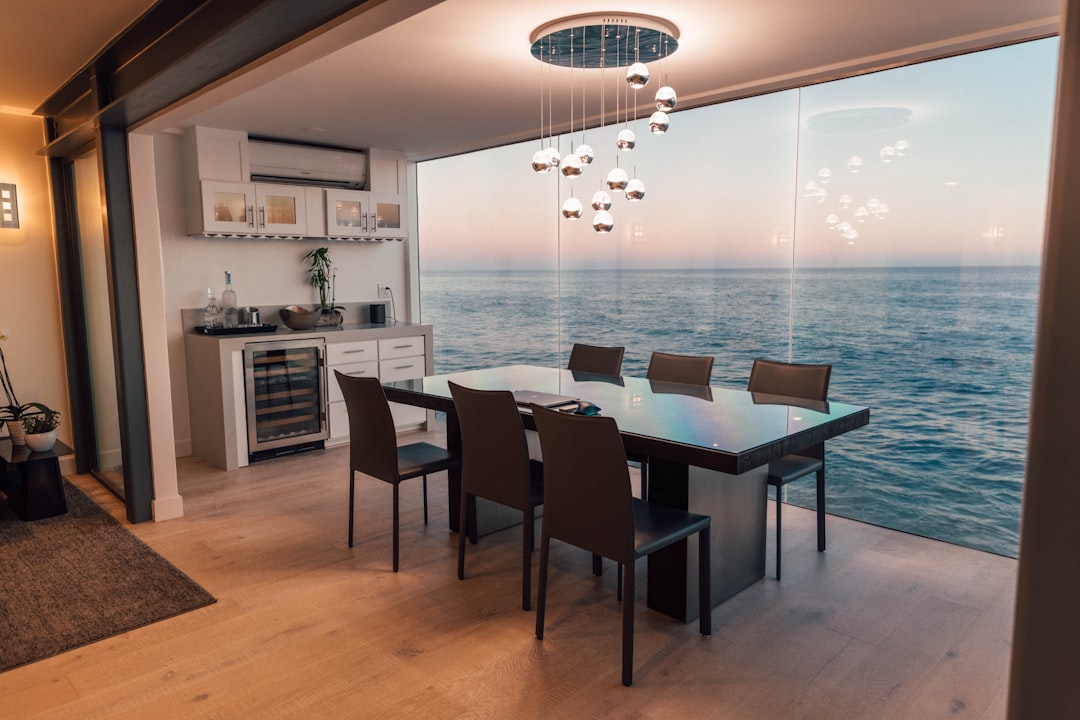Did you know nearly 75% of homeowners love mixing traditional and modern in their homes? This shows how popular transitional style interior design is. It combines the cozy feel of classic decor with the modern look of furniture and accessories.
This design is a great choice for those who don’t want to stick to just one design style. It lets homeowners create a space that’s both classic and contemporary.
In our journey through transitional interior design, we’ll learn how to mix classic and modern. This way, we can make our homes welcoming and stylish.
Key Takeaways
- Transitional design combines traditional and modern elements.
- It offers a unique and refreshing aesthetic.
- Blending classic and contemporary pieces creates a timeless look.
- Homeowners can personalize their space with eclectic decor.
- Transitional design is versatile and adaptable to various tastes.
What is Transitional Style Interior Design?
Transitional style interior design mixes traditional and modern elements. It creates a balanced look that never goes out of style. This makes it a favorite among homeowners.
We’ll dive into what makes transitional design special. You’ll learn how to bring this style into your home.
Defining Transitional Design
Transitional design is a mix of old and new. It combines traditional elegance with modern simplicity. This creates a welcoming space that’s both cozy and stylish.
For more on achieving balance in transitional design, check out our guide on striking the perfect balance.
Key Characteristics of Transitional Style
Transitional style is known for its neutral colors, mixed materials, and textures. These elements make a space look cohesive and inviting.
Let’s look at these characteristics in more detail:
| Characteristic | Description | Example |
|---|---|---|
| Neutral Color Palette | A mix of calming colors that provide a serene backdrop for other design elements. | Soft grays, creamy whites, and beige tones. |
| Mixed Materials | Combining different materials to add depth and interest to a room. | Pairing wood furniture with metal accents and fabric upholstery. |
| Blend of Textures | Incorporating various textures to create a visually appealing and tactile experience. | Mixing smooth surfaces like glass and metal with rougher textures like wood and woven fibers. |
By using these key elements, you can make a transitional style home that’s both beautiful and practical. Good transitional decorating tips include balancing elements and making sure the space feels welcoming.
The History of Transitional Interior Design
Exploring transitional interior design’s history reveals its evolution. It combines traditional and contemporary styles, creating a unique blend. This style has grown, taking bits from both to make something new and harmonious.
Influences from Traditional Design
Transitional design owes a lot to traditional styles. It uses classic lines, ornate details, and rich materials. For example, wood furniture with carvings and velvet and silk fabrics are traditional touches.
These elements add warmth and depth. They make transitional spaces feel grounded and comfortable, with a hint of history.
The Rise of Contemporary Elements
Contemporary elements have also shaped transitional design. Modern materials and clean lines have been added. This gives transitional design a fresh, updated look.
Using metallic accents and glass brings a modern touch. Yet, it keeps the warmth and coziness of traditional design. This balance makes transitional design both inviting and stylish.
The Importance of Balance in Transitional Spaces
Balance is key in transitional interior design. It mixes classic and modern styles smoothly. This balance makes spaces both beautiful and welcoming, showing off the owner’s style.
To get this balance right, knowing how to mix colors and textures is crucial. A balanced space looks good and feels right.
Creating a Cohesive Look
A cohesive look in transitional design combines old and new in a single statement. Here’s how:
- Choose a color scheme that ties everything together.
- Use different textures like wood, metal, and fabric for depth.
- Choose furniture that blends old and new styles.
For example, a wooden coffee table with a modern sofa in neutral fabric makes a cozy living room.
Mixing Textures and Colors
Mixing textures and colors is vital in transitional design. It makes spaces interesting and balanced. Here are some tips:
- Begin with a neutral base color and add colors through furniture and decor.
- Combine textures like smooth, rough, and soft to add depth.
- Add metallic accents for a touch of modern sophistication.
For instance, a neutral sofa can be enhanced with a bold rug, wooden accents, and metallic decor. This creates a lively and balanced space.
| Element | Traditional | Contemporary | Transitional |
|---|---|---|---|
| Furniture Style | Ornate, classic designs | Sleek, minimalist designs | A blend of classic and modern designs |
| Color Palette | Rich, bold colors | Neutral, monochromatic | A mix of neutral and bold colors |
| Textures | Heavy fabrics, carved wood | Smooth surfaces, glass | A mix of heavy fabrics, smooth surfaces, and natural materials |
Understanding balance and how to mix colors and textures helps create beautiful, functional spaces. Whether updating a room or your whole home, transitional design makes spaces more inviting and harmonious.
Essential Elements of Transitional Design
Creating a transitional space is all about mixing timeless and modern design. It’s about finding balance and harmony. We blend the comfort of traditional design with the sleekness of modern aesthetics.
To make a transitional interior, we focus on furniture, color, and lighting. Each part is key to the space’s look and feel.
Furniture Choices
Furniture in transitional design is a mix of classic and modern. We seek pieces that are both useful and beautiful. For example, a traditional sofa can go well with modern coffee tables in a living room.
- Choose furniture with clean lines and minimal ornamentation.
- Mix different materials, such as wood and metal, to add depth to the space.
- Opt for upholstered furniture with neutral fabrics that can be easily updated with throw pillows and blankets.
Color Palette
The colors in transitional design are neutral and soothing. They create a calm background for both traditional and modern pieces. Beige, gray, and taupe are common, with pops of color from accessories.
- Start with a neutral base color for walls and large furniture pieces.
- Add depth with varying shades of the base color.
- Introduce accent colors through smaller decorative items.
Lighting Fixtures
Lighting in transitional design is both functional and beautiful. We often mix different types of lighting. This creates a layered effect.
- Use a mix of table lamps and floor lamps to add warmth and ambiance.
- Select lighting fixtures that are simple yet elegant, avoiding overly ornate or too minimalist designs.
- Consider the scale of lighting fixtures in relation to the room and furniture.
By choosing the right furniture, colors, and lighting, we can create a beautiful and functional transitional interior. This style is timeless and can evolve with our tastes, making it perfect for any home.
How to Incorporate Transitional Style in Your Home
Transitional interior design can make your home welcoming and stylish. It blends classic and modern elements. This way, you can create a space that reflects your taste.
Living Room Inspirations
The living room is the heart of your home. Adding transitional style here can really change it. Choose furniture that mixes old and new.
For example, pair a traditional sofa with a modern coffee table. This mix creates a unique look.
Think about the colors too. Neutral shades like beige, gray, and taupe are key in transitional design. Use throw pillows and rugs in bold colors to add life to the room.
| Element | Traditional | Transitional | Contemporary |
|---|---|---|---|
| Furniture | Ornate carvings, rich fabrics | Clean lines, mixed materials | Sleek, minimalist |
| Color | Rich jewel tones | Neutral with pops of color | Bold and bright |
| Lighting | Crystal chandeliers | Simple fixtures with subtle elegance | Modern, geometric fixtures |
Kitchen and Dining Area Ideas
The kitchen and dining areas are key spots for transitional design. In the kitchen, mix traditional cabinets with modern appliances and sleek countertops. This mix makes the space both functional and stylish.
In the dining area, a transitional table and chairs with a modern light fixture create a sophisticated feel. Add decorative items like art or a centerpiece to finish the look.
By using these transitional design elements, you can make your home both classic and modern. It will be welcoming and stylish.
Common Mistakes to Avoid in Transitional Design
Creating a transitional interior design can be tough. It blends traditional and modern styles. You need to balance these elements carefully.
Knowing the common mistakes helps avoid them. This way, your space will be both beautiful and functional. Let’s look at some mistakes and how to steer clear of them.
Overuse of Patterns and Colors
Managing patterns and colors is a big challenge. It’s easy to get carried away with too many patterns and colors. This can make your space look busy.
- Stick to 2-3 main colors and use their variations for depth.
- Match patterns, like geometric with organic ones.
- Use a neutral background to highlight your furniture and decor.
Neglecting Functionality
Looks are important, but function is key. A beautiful space that’s not practical is useless.
Tips for Balancing Form and Function:
- Choose furniture that’s stylish and comfy.
- Think about your space’s flow and make sure it’s easy to move around.
- Add storage that looks good and works well.
By avoiding these mistakes, you can make a space that’s both lovely and practical. The secret to great transitional design is finding the right balance.
Choosing the Right Furniture for Transitional Spaces
To get a cohesive look in transitional design, picking the right furniture is key. It should mix different styles and materials well. The right pieces can tie a room together, blending old and new perfectly.
Mixing Wood and Upholstery
Transitional furniture often combines wood and upholstery. Mixing these adds depth and interest to a room. For example, a wooden coffee table with upholstered armchairs looks balanced and inviting.
When mixing wood and upholstery, think about textures and colors. A dark wood tone works well with soft, plush furniture. This mix makes the room look modern and stylish.
| Furniture Piece | Material | Style |
|---|---|---|
| Coffee Table | Dark Wood | Classic |
| Armchairs | Upholstered Fabric | Contemporary |
| Sofa | Leather Upholstery | Modern |
Selecting Timeless Pieces
Choosing timeless furniture is key for a transitional space. These pieces should be both useful and stylish, lasting for years. Investing in quality is smart, as it keeps your furniture looking good for a long time.
Look for furniture with clean lines, simple shapes, and quality materials. Stay away from too much ornament or trendy designs. A classic piece can be the base of your transitional space, making it stylish and cohesive.
By picking furniture that mixes materials and styles, and choosing timeless pieces, you can make a beautiful transitional space. This approach makes your home look great and adds a modern touch that’s welcoming and sophisticated.
Integrating Art and Accessories
Art and accessories are key in making transitional interiors balanced and harmonious. They add visual interest and bring personality to the space.
Choosing art for a transitional design is important. Look for pieces that mix traditional and modern styles. For example, a modern abstract piece with neutral colors can match traditional furniture, creating a nice contrast.
Choosing the Right Art Pieces
To effectively add art to a transitional space, follow these tips:
- Choose art with different frame styles and shapes for depth.
- Use art to draw attention to a specific area in the room.
- Make sure the art fits the room’s color and texture.
“The right art piece can transform a room, turning it into a reflection of one’s personal style.” – A renowned interior designer once said, highlighting the impact of art in interior design.
Functional Decorative Accessories
Decorative accessories in transitional design should look good and be useful. Items like vases, baskets, and decorative boxes can add to the room’s utility while keeping its style.
For example, a wooden chest can be a coffee table and a storage unit, blending function with style. Decorative trays can organize items on tables, keeping the space tidy.
Key considerations for functional decorative accessories include:
- Choosing items that match the room’s color and texture.
- Making sure the accessories are practical.
- Not overdoing it to avoid clutter.
By carefully choosing art and accessories for a transitional design, homeowners can create a beautiful and personal space. These elements are essential in making a home harmonious and inviting.
“The beauty of transitional design lies in its ability to blend the old with the new, creating a unique and captivating aesthetic.”
Maintenance Tips for Transitional Interiors
Maintaining a transitional interior is all about balance. It combines classic and modern elements beautifully. To keep it looking great, regular care is essential.

Regular Care for Furniture and Decor
Keeping your transitional interior in top shape is key. Start by dusting and polishing furniture regularly to avoid dust buildup. Use gentle cleaning products on upholstered furniture to prevent damage.
Wooden furniture benefits from a wood conditioner now and then. Also, rotate and flip cushions and mattresses to ensure even wear.
- Use coasters and placemats to protect surfaces from water marks and spills.
- Avoid direct sunlight on furniture to prevent fading.
- Keep decorative items clean and dust-free.
Updating the Look Over Time
Updating your transitional interior is easy. Just add new decorative accessories or change the layout. Consider introducing new art pieces or textiles that fit the style.
To update without losing the style, focus on replacing or reupholstering key furniture pieces. You can also update lighting fixtures for a fresh look.
| Update Idea | Description | Benefit |
|---|---|---|
| Add new throw pillows | Introduce new colors or patterns | Refreshes the space |
| Rearrange furniture | Create a new layout | Gives a new feel without new purchases |
| Update lighting | Install new fixtures | Modernizes the space |
By following these tips, your transitional interior will stay beautiful and functional. It will remain inviting and stylish for years to come.
Conclusion: Embracing Transitional Design in Our Spaces
Transitional style interior design mixes classic and modern elements. This creates a look that is both timeless and harmonious. By understanding its key features, we can make our homes look great.
Versatility in Design
Transitional style is all about mixing different textures, colors, and furniture. This makes it easy to create a space that’s truly yours. For more ideas, check out Cozy Nest Plans for expert tips.
Designing with Harmony
The secret to successful transitional design is finding harmony among different elements. Choosing the right furniture, colors, and lighting is key. This way, we can make our homes welcoming and stylish, perfect for those who love elegance and balance.



